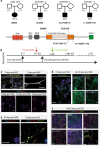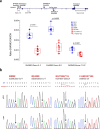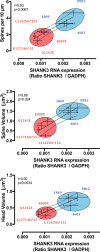Altered spinogenesis in iPSC-derived cortical neurons from patients with autism carrying de novo SHANK3 mutations
- PMID: 30643170
- PMCID: PMC6331634
- DOI: 10.1038/s41598-018-36993-x
Altered spinogenesis in iPSC-derived cortical neurons from patients with autism carrying de novo SHANK3 mutations
Abstract
The synaptic protein SHANK3 encodes a multidomain scaffold protein expressed at the postsynaptic density of neuronal excitatory synapses. We previously identified de novo SHANK3 mutations in patients with autism spectrum disorders (ASD) and showed that SHANK3 represents one of the major genes for ASD. Here, we analyzed the pyramidal cortical neurons derived from induced pluripotent stem cells from four patients with ASD carrying SHANK3 de novo truncating mutations. At 40-45 days after the differentiation of neural stem cells, dendritic spines from pyramidal neurons presented variable morphologies: filopodia, thin, stubby and muschroom, as measured in 3D using GFP labeling and immunofluorescence. As compared to three controls, we observed a significant decrease in SHANK3 mRNA levels (less than 50% of controls) in correlation with a significant reduction in dendritic spine densities and whole spine and spine head volumes. These results, obtained through the analysis of de novo SHANK3 mutations in the patients' genomic background, provide further support for the presence of synaptic abnormalities in a subset of patients with ASD.
Conflict of interest statement
The authors declare no competing interests.
Figures





Similar articles
-
A chimeric mouse model to study human iPSC-derived neurons: the case of a truncating SHANK3 mutation.Sci Rep. 2020 Aug 7;10(1):13315. doi: 10.1038/s41598-020-70056-4. Sci Rep. 2020. PMID: 32769989 Free PMC article.
-
SHANK3 mutations identified in autism lead to modification of dendritic spine morphology via an actin-dependent mechanism.Mol Psychiatry. 2012 Jan;17(1):71-84. doi: 10.1038/mp.2011.57. Epub 2011 May 24. Mol Psychiatry. 2012. PMID: 21606927 Free PMC article.
-
Stem cell-derived neurons from autistic individuals with SHANK3 mutation show morphogenetic abnormalities during early development.Mol Psychiatry. 2018 Mar;23(3):735-746. doi: 10.1038/mp.2017.185. Epub 2017 Sep 26. Mol Psychiatry. 2018. PMID: 28948968 Free PMC article.
-
Actin-Dependent Alterations of Dendritic Spine Morphology in Shankopathies.Neural Plast. 2016;2016:8051861. doi: 10.1155/2016/8051861. Epub 2016 Oct 4. Neural Plast. 2016. PMID: 27795858 Free PMC article. Review.
-
Modeling autism by SHANK gene mutations in mice.Neuron. 2013 Apr 10;78(1):8-27. doi: 10.1016/j.neuron.2013.03.016. Neuron. 2013. PMID: 23583105 Free PMC article. Review.
Cited by
-
Human stem cell-based models for studying autism spectrum disorder-related neuronal dysfunction.Mol Autism. 2020 Dec 11;11(1):99. doi: 10.1186/s13229-020-00383-w. Mol Autism. 2020. PMID: 33308283 Free PMC article. Review.
-
Male caregiving experience alters hippocampal neuroplasticity and transcription independent of reproduction in a biparental species.Commun Biol. 2025 Aug 13;8(1):1212. doi: 10.1038/s42003-025-08530-w. Commun Biol. 2025. PMID: 40804339 Free PMC article.
-
Transcriptional signatures of participant-derived neural progenitor cells and neurons implicate altered Wnt signaling in Phelan-McDermid syndrome and autism.Mol Autism. 2020 Jun 19;11(1):53. doi: 10.1186/s13229-020-00355-0. Mol Autism. 2020. PMID: 32560742 Free PMC article.
-
A framework for an evidence-based gene list relevant to autism spectrum disorder.Nat Rev Genet. 2020 Jun;21(6):367-376. doi: 10.1038/s41576-020-0231-2. Epub 2020 Apr 21. Nat Rev Genet. 2020. PMID: 32317787 Free PMC article. Review.
-
A recurrent SHANK3 frameshift variant in Autism Spectrum Disorder.NPJ Genom Med. 2021 Nov 4;6(1):91. doi: 10.1038/s41525-021-00254-0. NPJ Genom Med. 2021. PMID: 34737294 Free PMC article.
References
Publication types
MeSH terms
Substances
LinkOut - more resources
Full Text Sources
Research Materials

